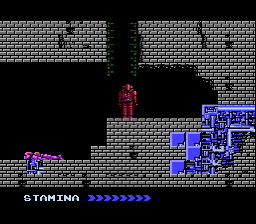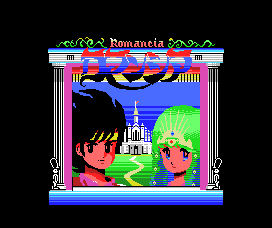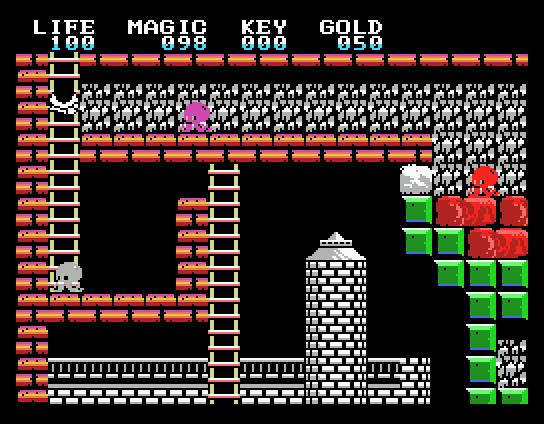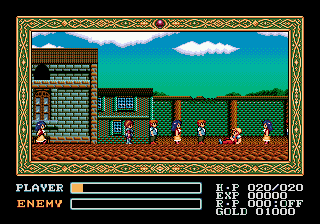Results
Relics: Ankoku Yosai
dark, melancholy, horror
Relics: Ankoku Yosai, released in 1987 for the MSX2 and later ported to other platforms, is a unique and ambitious action-adventure game that stands out in the crowded genre of its time. Developed by Nihon Falcom, the game is set in a post-apocalyptic world where humanity has been nearly wiped out by a cataclysmic event, and the player takes on the role of a lone survivor tasked with unraveling the mysteries of the past and finding a way to restore the world. One of the game's standout features is its non-linear exploration and level design. Players are free to navigate the vast, interconnected world at their own pace, with multiple paths and secrets to uncover. The game encourages backtracking and revisiting previously explored areas as new abilities and items are obtained, adding depth and replayability to the experience. The combat system in Relics: Ankoku Yosai is also noteworthy. While it features traditional action-adventure combat mechanics, it also incorporates RPG elements such as character progression, equipment management, and a unique skill system. Players can learn and upgrade various abilities, allowing for strategic customization of their character's playstyle. The game's narrative is delivered through a combination of in-game events, environmental storytelling, and optional side quests and interactions. The world is rich with lore and mystery, and players are encouraged to piece together the narrative through exploration and discovery. Additionally, Relics: Ankoku Yosai features an impressive soundtrack that complements the game's atmospheric and often haunting environments. The music shifts seamlessly between different tracks, creating a dynamic and immersive audio experience. Despite its age, Relics: Ankoku Yosai is often praised for its ambitious design, compelling storytelling, and innovative gameplay mechanics that set it apart from its contemporaries. It is considered a cult classic among fans of the action-adventure genre and a notable entry in Nihon Falcom's catalog of games.
Romancia: Dragon Slayer Jr.
fantasy, grindy, environmental puzzles
Romancia: Dragon Slayer Jr. is a side-scrolling action role-playing game developed by Nihon Falcom and released for the Super Famicom in 1994. As a spin-off of the Dragon Slayer series, it blends elements of traditional action platformers with RPG mechanics. One of the game's notable features is its nonlinear level design, allowing players to explore the interconnected world and tackle areas in different orders. This open-ended approach encourages backtracking and revisiting previously inaccessible areas as the protagonist, Lyle, gains new abilities and equipment. The combat system incorporates both real-time action and turn-based elements. Players can freely move and attack enemies in real-time, but certain abilities and spells are executed through a separate menu-based system, adding a layer of strategy to the otherwise fast-paced combat. Romancia: Dragon Slayer Jr. also features an extensive character progression system, with various skills, spells, and equipment to acquire and upgrade. Lyle can learn new abilities by finding and equipping specific gear, encouraging players to experiment with different loadouts and playstyles. The game's world is filled with hidden secrets, optional bosses, and challenging dungeons, catering to players who enjoy exploration and seeking out optional challenges. Additionally, the game features multiple endings, incentivizing replay value and encouraging players to uncover all the game's secrets. While the game's graphics and audio were impressive for its time, Romancia: Dragon Slayer Jr. is particularly noteworthy for its innovative fusion of action and RPG elements, as well as its emphasis on nonlinear exploration and character progression.
Legacy of the Wizard
fantasy, environmental puzzles, hidden areas
Legacy of the Wizard, released in 1987 for the Nintendo Entertainment System, is a unique blend of action and puzzle-solving elements, set in a fantasy world. Developed by Sculptured Software and published by Broderbund, the game stood out with its innovative gameplay mechanics and challenging level design. One of the game's standout features was its emphasis on exploration and environmental manipulation. Players assumed the role of a wizard, tasked with navigating intricate dungeons and solving puzzles to progress. Unlike many contemporaneous action games, Legacy of the Wizard required a thoughtful approach, as simply hacking and slashing wouldn't suffice. The game's puzzles were cleverly integrated into the environment, often requiring players to manipulate objects, trigger switches, or use specific spells to overcome obstacles. This added an extra layer of depth and complexity, as players had to carefully observe their surroundings and think critically to proceed. Another noteworthy aspect of Legacy of the Wizard was its innovative spell system. Players could learn and cast various spells, each with unique abilities and applications. These spells not only served as weapons against enemies but also as tools for solving puzzles, adding a strategic element to the gameplay. The game's level design was meticulously crafted, with each dungeon presenting a fresh challenge and requiring players to adapt their strategies. Secret passages, hidden rooms, and unexpected traps kept players on their toes, encouraging exploration and rewarding observant players. Legacy of the Wizard's graphics were impressive for their time, with detailed environments and character sprites that brought the fantasy world to life. The game's soundtrack, composed by David Warhol, was equally noteworthy, creating an immersive and atmospheric experience. While not a commercial success upon its initial release, Legacy of the Wizard gained a cult following among NES enthusiasts and gamers who appreciated its unique gameplay mechanics and challenging puzzles. It remains a beloved classic and a testament to the creativity and innovation that defined the golden era of NES gaming.
Ys III: Wanderers from Ys
fantasy, environmental puzzles, interconnected world
Ys III: Wanderers from Ys, released in 1989 for the PC-8801 and later ported to various other platforms, represents a significant departure from its predecessors in terms of gameplay mechanics and narrative approach. One of the most notable changes is the shift from the top-down perspective of the previous entries to a side-scrolling format. This alteration in perspective not only introduced a new level of depth and complexity to the combat system but also allowed for more intricate level design and environmental puzzles. The game's narrative takes a more somber and mature tone, delving into themes of loss, sacrifice, and the consequences of past actions. The story follows the journey of Adol and Dogi, the protagonists of the first two games, as they navigate the aftermath of the events that transpired in Ys II, exploring the ramifications of their choices and grappling with the weight of their responsibilities. Ys III also introduced a more substantial emphasis on character development, with NPCs playing a more significant role in driving the narrative forward and offering insights into the game's lore and world-building. While retaining the series' signature fast-paced action and challenging boss battles, Ys III incorporated a more robust equipment system, allowing players to customize their characters' gear and abilities to suit their preferred playstyle. The game's soundtrack, composed by the legendary Falcom Sound Team JDK, is widely regarded as a highlight, with its fusion of rock and classical elements perfectly complementing the game's tone and pacing. Overall, Ys III: Wanderers from Ys represented a bold step forward for the series, showcasing the developers' willingness to experiment with new gameplay mechanics and narrative approaches while maintaining the core elements that made the previous entries so beloved.
Filters
Search Term
Properties
Platforms
Tags (include)
Tags (exclude)
Get Your Game Noticed
Advertise your game with MetroidvaniaDB and reach a community of people who know exactly what they're looking for:
Your game.
Native & Banner Ad Spots
Multi-week Discounts
Game Launch Packages
Discounts for Indie Developers




